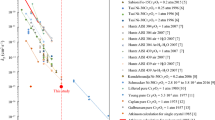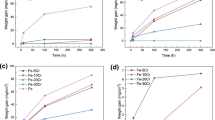Abstract
The oxidation behavior of pure chromium and ODS-Cr alloys in Ar-H2-H2O and Ar-O2-H2O was studied at 1000°C. At high oxygen potentials, the addition of H2O to the gas had negligible effect on the scaling behavior. However, at low oxygen potentials, when the pH2O/pH2 ratio was held constant, the oxidation rate increased with water partial pressure. Increasing values of pH2O/pH2 led to more rapid rates. At fixed pH2O values, the rate increased with increasing pH2. Compact scales were formed under all conditions. In addition Cr2O3 blades grew on the scale surface when pure chromium was reacted with H2O/H2 mixtures, but not in reaction with O2/H2O. These blades did not form when Y2O3 dispersion-strengthened material was reacted. A model, in which oxide growth was sustained by diffusion of chromium vacancies and adsorption of H2O on oxide exposed to low oxygen-activity gas led to the formation of hydroxyl species, explained most of the complex effects of gas composition on scale growth and blade formation. However, it failed to account for the observed increase in scaling rate with pH2 at fixed pH2O. The latter effect is ascribed to alteration of an additional contribution to diffusion from chromium interstitials.
Similar content being viewed by others
REFERENCES
W. Wersing, E. Ivers-Tiffe, M. Schiessl, and H. Greiner, Proc. Symp. Solid Oxide Fuel Cells, Nagoya, Japan, 13–14 Nov. 1989 (Science House, Tokyo), 1989, p. 33.
W. J. Quadakkers, H. Greiner, and W. Köck, Proc. First European Solid Oxide Fuel Cell Forum, 3–7 October 1994 (Lucerne, Switzerland, 1994), p. 525.
H. P. Martinez and W. Köck, Industrie 46, 26(1993).
Th. Malkow, W. J. Quadakkers, H. Nickel, and L. Singheiser, Jül-Bericht 3589, ISSN 0944–2952, FZ Juelich, IWV-2 (1998).
M. Hänsel, W. J. Quadakkers, L. Singheiser, and H. Nickel, Jül-Bericht 3583, ISSN 0944–2952, FZ Juelich, IWV-2 (1998).
W. J. Quadakkers, J. F. Norton, S. Canetoli, K. Schuster, and A. Gil, Proc. 3rd Conf. Microscopy of Oxidation, p. 609(1996).
X. G. Zheng and D. J. Young, Oxid. Met., 42, 163–190 (1994).
F. Armanet, A. Vejux, G. Johannesson, and G. Beranger, Oxid. Metals 15, 3–8 (1981).
E. A. Polman, T. Fransen, and P. J. Gellings, Oxid. Met., 32, 433–447 (1989).
S. Roure, F. Czerwinski, and A. Petric, Oxid. Met., 42, 75–102 (1994).
F. Armanet, G. Beranger, and D. David, Proc. 8th Intern. Congr. Metallic Corros. (DECHEMA, Frankfurt, 1981), p. 735–738
G. Raynaud and R. Rapp, Oxid. Met. 21, 89(1984).
D. A. Voss, E. P. Butler, and T. E. Mitchell, Metall. Trans. A 13, 929–935 (1982).
F. C. Frank, Acta Crystallogr. 4, 497–550 (1951).
N. A. Gokcen, J. Amer. Chem. Soc. 73, 3789(1951).
C. T. Lynch, ed., Handbook of Materials Science, (CRC Press, Cleveland, Ohio, 1974), p. D-180.
D. L. Douglass, P. Kofstad, A. Rahmel, and G. C. Wood, Oxid. Met. 45, 529–620 (1996).
C. Wagner, Z. Phys. Chem. B 21, 25(1933).
C. Wagner, and K. Grünwald, Z. Phys. Chem. B 32, 447(1937).
C. Wagner and K. Grünwald, Z. Phys. Chem. B 40, 455(1938).
P. Kofstad, Oxid. Met. 44, 3(1995).
P. Kofstad and K. P. Lillerud, J. Electrochem. Soc. 127, 2410(1980).
P. Kofstad, High Temperature Corrosion (Elsevier Science, New York, 1988).
F. A. Kröger, The Chemistry of Imperfect Crystals, 2nd edn. (North-Holland, Amsterdam, 1974).
B. Tveten, G. Hultquist, and T. Norby, Oxid. Met. 51, 221(1999).
T. Norby, J. Phys. IV 3, 99(1993).
T. Norby, Adûan. Ceram. 23, 107(1987).
W. J. Quadakkers, H. Holzenbrecher, K. Briefs, and H. Beske, in The Role of Actiûe Elements: the Oxidation Behaûior of High Temperature Metals and Alloys (E. Lang, ed., Elsevier, London, 1988).
B. A. Pint, Oxid. Met. 45, 1(1996).
W. J. Quadakkers, J. F. Norton, J. H. Penkalla, U. Breuer, A. Gil, T. Rieck, and M. Hänsel, Proc. 3rd Conf. Microscopy of Oxidation, p. 221(1996).
Author information
Authors and Affiliations
Rights and permissions
About this article
Cite this article
Hänsel, M., Quadakkers, W. & Young, D. Role of Water Vapor in Chromia-Scale Growth at Low Oxygen Partial Pressure. Oxidation of Metals 59, 285–301 (2003). https://doi.org/10.1023/A:1023040010859
Issue Date:
DOI: https://doi.org/10.1023/A:1023040010859




